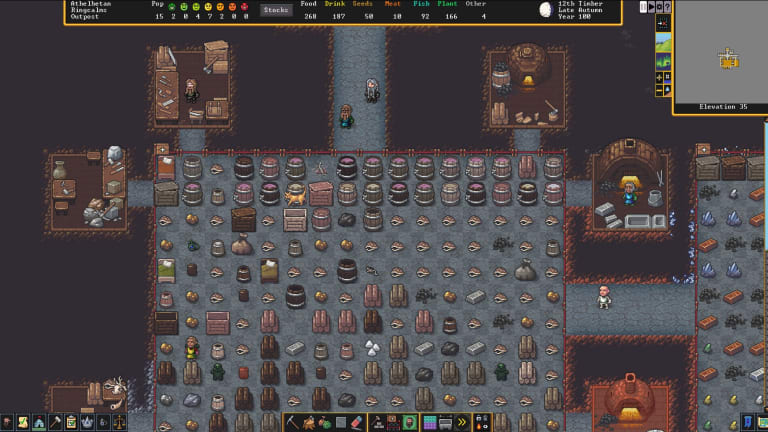
Dwarf Fortress beginner tips to start building your civilization right
It's the forefather of Rimworld and numerous other colony simulations. Dwarf Fortress has been in development for over ten years by a small and passionate team, and is considered one of the most complex and deep games ever made. In minutes, it simulates the personalities and lives of thousands of beings and writes the histories of entire civilizations – and all this just to let you start out in a living, breathing world where you'll have to try your luck with your own settlers.
Luck is indeed part of the game. It may be that in the first minute of the game a wild crocodile eats two of your dwarves, the rest of the group becomes depressed and due to the resulting lethargy they all starve. Or a tree falls on your lumberjack, crippling them. Or someone falls into the only puddle of water far and wide and can't swim, thus drowning. Or a vampire sneaks into your fortress and gradually turns all your dwarves into bloodsuckers. The possibilities of failure are quite literally endless.
The game's motto – losing is fun – couldn't be more fitting and true. In Dwarf Fortress you set your own goals: Do you want to build the most powerful civilization on the continent, become a nexus of master craftsmen, or just make all your charges happy? The Steam edition has made the ASCII game more accessible, but hasn't changed anything in terms of depth, so whatever your ambition may be, you have to know a few things to get off to a good start.
These tips for beginners will help you survive the first year in Dwarf Fortress.
Dwarf Fortress Tips: Choosing the right starting position
A run in Dwarf Fortress begins with the creation of a world, its inhabitants, and its history. You are then allowed to choose a location where you want to create your fortress. Beginners should pay attention to some aspects and use the filter option on the bottom right side of the screen.
To make the start as easy as possible, filter out all places with aquifers – these are layers of earth filled with water that can all too easily flood your entire fortress without some advanced countermeasures. You also want to make sure there are layers of Flux Stone in your area – this is a necessary material to create steel, one of the most important resources. The default settings to start should otherwise ensure that you find plenty of other materials.
Confirm the filter and let the game find suitable locations. It will then show these on the map and you can choose where you want to settle. It is also recommended that you choose a place with accessible trees – this way you'll reliably have access to wood without having to buy it from merchants.
You can customize your settler group and starting resources, but for the beginning the default set is quite sufficient.
Dwarf Fortress Tips: Work distribution
You start the game in paused mode, and you should begin by surveying your surroundings. Dwarves naturally only feel comfortable underground, but it's wise to look for a strategically located place for the entrance to your fortress – it should be easily defensible as well as have water and trees nearby. To start, use the tools in the bottom bar to command your people to cut down some trees and gather plants – this will give everyone something useful to do.
Use the appropriate tool to dig a staircase to dig down a few levels and lay the foundation for your fortress. Once you've given the commands in the order given above, you may notice that your miner with the pickaxe isn't actually doing any digging, but is instead collecting plants with the other dwarves. You don't want that to be the case.

Locking a dwarf into a certain job category will make sure their skills in that particular job grow.
Using the bar at the bottom, go to your list of citizens and find your miner. Click on the green button on the right. This will make your miner only do work that needs their expertise. In the work menu, you can further tune which dwarves should do which jobs – always keep an eye on this to make sure that everything runs smoothly in your fortress and that important jobs are actually done by the most suitable people. This has the additional effect of making the dwarves train that particular skill and get better results.
Dwarf Fortress Tips: Fortress layout
Once your staircase (white) – a 4x4 area is perfectly sufficient – has reached the target level, you should create a few basic rooms down there: you need a large storage room (red), where you can place a stockpile zone so that your goods do not lie unprotected on the surface.
Connected to this, you'll have a few smaller 3x3 rooms (yellow) where you'll set up workshops – Carpenter (for wood products), Stonecutter (for stone products), Crafts (for export products) and Still (for beverages) are the first important workshops for the beginning.
After that you should dig a dining hall (blue) and define it as a meeting place – this is done by the zoning tool in the bar.
To start, not every dwarf needs their own room with a bed, so start with a small dormitory (green). Again, you’ll need to zone this appropriately. You will also need two small offices with a chair and a table each (purple) to implement our next important tip.
The corridors in your fortress should always be at least two squares wide – otherwise dwarves will keep bumping into each other, which slows down their pace.
Dwarf Fortress Tips: Appoint a manager, use Work Orders
The reason why you should include two small offices in your starting layout is that you should appoint a manager and a bookkeeper as early as possible. You can do this by clicking on the crown icon in the bar below. The game will make suggestions to you based on the skills of the dwarves as to who you should give the positions to. Dwarves with such roles need an office to fulfil them reasonably. In the beginning, a cubbyhole with a chair and a table will do, but later the budding nobles will want a bit more pizzazz in their rooms.
A manager and a bookkeeper will be necessary for your fortress to run smoothly.
The manager unlocks additional work management features that are exceedingly important. Without a manager, you can only schedule ten jobs at a workshop, which will delete themselves if there are problems – such as a shortage of a resource. This quickly leads to chaotic conditions and you would have to check every minute whether all ongoing production chains are still intact.
However, the manager unlocks Work Orders, which you can access via the clipboard button in the bar. This feature allows you to give more specific orders – for example, ordering ten stone tables and 20 matching chairs. However, you can also give commands that are linked to certain conditions. For example, it is a waste of material and time to build infinite barrels for storing drinks, when there is currently no drink production.
Via Work Order you can, for example, set your dwarves to only build more barrels if there are fewer than five empty barrels currently in your warehouses. The game checks every day if the conditions for the order are met and passes them on to the dwarves if that’s the case. These Work Orders are the key to the successful – and somewhat relaxing – management of your fortress.
The second office is for your bookkeeper. Staffing this post is important because only such an accountant can determine how many goods you actually have in your fortress – in fact, until you name a bookkeeper you will only see estimates.
Dwarf Fortress Tips: Trade
The most important building on the surface is the trade depot. This is where the caravans that travel through the country head to. A broker appointed by you can trade there. It's lucrative to always have a job running producing export goods that you can trade for anything else you need.
Caravans will also ask you what they should bring in the coming year – goods like seeds for crops and cloth should be on your shopping list at the start. You'll also get a hint about what the caravan would like to buy up the next time they visit. If you can produce these goods in your fortress, it is definitely worth it to invest some time into making these wares.
If a caravan arrives at your depot, follow these steps to trade:
- Send your trade goods to the depot (be sure to build bins at the Carpenter for this purpose).
- Send your broker to the depot.
- Use the Trade button to buy and sell goods.
If the foreign trader does not make a sufficient profit (a green number), he may lose patience and may not trade with you, so be as generous as necessary to get the deal through.
Dwarf Fortress Tips: Food and drinks
Dwarves get disgruntled pretty quickly without alcohol. To be able to produce beer or wine, you need to do some farming. The best soil for this is the earth in caves, but these are not available to you at the beginning. Therefore, dig a few fields one level below the surface – the usual size people like to go for is 5x5, but it doesn’t matter all that much. Grow Plump Helmets and other plants there to ensure you have a constant supply.
At first, raw food will be enough for your charges, later the demands will increase and you will have to cook better dishes in a kitchen workshop.
You already have a few tame animals at the start of the game. Create a zone for them to graze on the surface and build a farmer's workshop – in it, you'll milk and shear your livestock.
Dwarf Fortress Tips: Metal Industry
The last beginner tip concerns the metal industry – after all, at some point, you will need good weapons to defend your fortress. When digging underground, you'll come across different types of rocks that have all sorts of properties. Some carry gemstones that you can cut and turn into artistic productions, others are usable as coal, and others carry ores such as iron and silver. Clicking on a lump of rock will show you all this info.
Once you have discovered such a vein, use the auto-mining function – this can be accessed from the digging tool by clicking on the right arrow. Use it to mark the ore you want, and your miners will mine all the linked deposits of the raw material on their own.

Expand the mining options by clicking the highlighted arrow. Auto-mining is useful for getting valuable materials.
For steel production – from which you want to make most of your weapons and armor – you'll need coal, iron ore, and flux stone, which you'll have to process via smelting furnaces. A thriving metal industry will hopefully ensure the future and security of your settlement.
From here on, fulfill the needs of your dwarves and follow your personal game goal – and remember: losing is fun!










